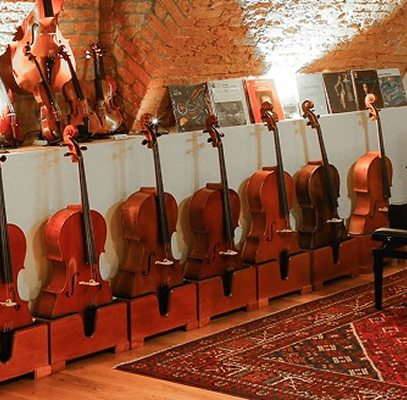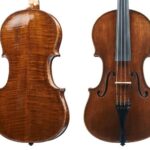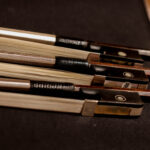How to Choose the Right Cello Strings for Your Sound
Back to BlogThe cello’s four strings (C, G, D, and A) define its expressive sound, moving from deep and resonant to bright and lyrical. Knowing how each one contributes to the instrument’s voice is essential for understanding its versatility and character.
Have you ever wondered why two cellists playing the same piece can sound so completely different? Often, the answer lies in something simple yet transformative: the cello strings.
Choosing the right cello strings can change your sound dramatically, affecting tone, response, and comfort.
Whether you’re a beginner learning the fundamentals or a seasoned performer fine-tuning your instrument, understanding how strings work is key to finding your ideal sound.
What are the 4 strings on a cello?
The cello belongs to the family of stringed instruments. It has four strings tuned in perfect fifths: C, G, D, and A, from lowest to highest pitch. A helpful way to remember this is the classic phrase “Cats Go Down Alleys.”
Each string plays a unique role in shaping the cello’s tonal range.
C String (Lowest)
Dark, powerful, and deeply resonant, the C string is the cello’s foundation. Its tone is rich and commanding, capable of evoking a sense of gravity and depth that anchors the entire instrument. It’s ideal for dramatic bass lines, warm harmonies, and passages that call for emotional weight and intensity. A well-balanced C string can make the whole cello sound broader and more mature.
G String
Earthy, round, and expressive, the G string acts as the bridge between the cello’s low resonance and its lyrical upper range. It carries warmth while still retaining clarity, often becoming the most expressive and “soulful” voice of the instrument.
Many cellists describe the G string as where the cello truly begins to “sing,” offering a palette of colors that can shift from mellow and intimate to bold and fullbodied.
D String
Bright yet supple, the D string is the cello’s most versatile string. It blends effortlessly with the G below and the A above, making it central to lyrical playing and melodic phrasing. Its clear and flexible sound works beautifully in cantabile passages, providing both warmth and brilliance. When wellchosen, the D string enhances the cello’s overall balance and tonal fluidity.
A String (Highest)
Shining and expressive, the A string is the cello’s voice in its purest form — where melodies soar and emotions reach their peak. It projects easily, cutting through with clarity and brilliance, yet can also whisper with tenderness and delicacy. A responsive A string allows the player to shape every nuance, from passionate climaxes to the softest lyrical lines.
Each string responds differently depending on its material (gut, synthetic, or steel) and tension, and the ideal balance depends on your cello’s personality and your playing technique.
How Often You Should Change your Stings?
A common mistake that beginner cellists tend to make is not changing their cello strings regularly. However, the reality is that strings wear out gradually. Even when they still sound acceptable, old strings lose their overtones, responsiveness, and clarity. As a rule of thumb:
- Professional or daily players: every 3 or 6 months
- Regular students or amateurs: from 6 to 12 months
- Occasional players: at least once a year
If you notice difficulty staying in tune, a dull or metallic tone, or fraying at the bridge or nut, it’s time for a replacement. Regular string changes not only refresh your sound but also protect your instrument from uneven tension and potential bridge warping.
Advices for Buying Your Next Cello Strings
Finding the perfect set of strings is a balance between type, gauge, performance, and environment. Let’s explore each aspect:
1. String Type
You can find three main types of cello strings on the market based on their material: gut-core, synthetic-core, and steel-core.
Gut-core strings
The oldest and warmest option. They produce a rich, complex tone with beautiful resonance but require frequent tuning and care in humid or cold climates. Ideal for baroque and classical repertoire or for players seeking a natural, expressive sound.
Synthetic-core strings
The modern favorite. They imitate gut’s warmth but with better stability and longevity. Perfect for orchestral or chamber musicians who need versatility and consistent intonation.
Steel-core strings
Bright, powerful, and highly durable. They project well and stay in tune under demanding conditions, making them excellent for contemporary, electric, or touring players. Make sure to analyze the pros and cons of each type to discover what works best for your instrument and playing style.
2. Gauge or Thickness
Cello strings come in light, medium, and heavy gauges, which influence tone and feel:
Light gauge: easier to play, faster response, slightly less volume.
Medium gauge: balanced tone and playability; best for most instruments.
Heavy gauge: darker, louder sound but requires more bow pressure.
Your cello’s build and your bowing strength will determine which gauge suits you best.
3. Performance Goals
Every cellist’s sound is shaped by their musical goals, playing environment, and personal touch (and your strings should reflect that)
For instance, soloists often gravitate toward higher tension or steel-core strings because they deliver exceptional projection and clarity under pressure.
These strings cut through orchestral textures, making every note shine with precision and brilliance. They respond quickly to the bow, offering the power and intensity needed for concert halls and solo performances.
Ensemble or chamber musicians, on the other hand, tend to seek warmth, depth, and blend. Synthetic-core or gut-core strings are ideal for these players, as they produce a rounder tone that merges beautifully with other instruments. They allow for subtle phrasing and nuanced dynamics, perfect for intimate settings where musical dialogue matters more than volume.
Lastly, students and developing players benefit most from reliable, budget friendly strings that stay in tune and respond easily to the bow and fingers. These strings make daily practice smoother and help build consistency in tone production without demanding constant adjustments or advanced technique.
4. Trusted Brands to Consider
When it comes to cello strings, certain brands have earned a strong reputation for consistency, tone quality, and craftsmanship.
For example, Larsen Strings are known for their rich tone and quick response, particularly in the Larsen Magnacore and Original series. Thomastik-Infeld, on the other hand, is prized for its projection, clarity, and durability.
Jargar remains a trusted choice for both students and professionals, offering a balanced tone and great value.
For modern and versatile players, many tend to rely on the steel-core strings from D’Addario Helicore, known for their stability and bright sound.
Each brand brings its own personality, so the best way to find your match is through careful experimentation. And if you have further doubts, try to seek guidance from your teacher or luthier.
5. Listen to your cello
Every cello has its own voice, and discovering it takes time. What sounds full and resonant on one instrument may feel muted or harsh on another. This is why trial and error is an essential part of finding your perfect setup.
Start by listening carefully to how your cello reacts to different string types and tensions. Does it open up with steel-core strings or sing more warmly with synthetic ones? Pay attention to response, projection, and balance across all four strings.
Sometimes, a small change, like switching to a lighter gauge or pairing strings from different brands, can unlock a more expressive, natural sound. Your cello will tell you what it likes best if you take the time to listen.
Above all, patience and curiosity are key. Finding your ideal strings isn’t about copying another player’s setup, it’s about developing a dialogue with your own instrument until its voice truly feels like your own.
Taking Care of The Strings
Proper maintenance can extend the life and tone of your cello strings significantly. Some tips from our luthiers are:
- Clean regularly: After every practice or performance, gently wipe your strings with a dry cloth to remove rosin and sweat.
- Avoid touching them with oily fingers: Natural oils corrode the surface and dull the sound.
- Check for wear: Look for fraying near the bridge or nut. Replace strings one at a time to maintain bridge and soundpost balance.
- Store your cello safely: Keep it in a stable, moderate environment to prevent sudden tension changes.
Discover the best strings to craft your unique sound
A clean, well-tuned set of strings will reward you with responsiveness, beauty, and longevity. All vital for achieving the finest sound your cello can offer.
Choosing the right cello strings isn’t only about brand or price: it’s about finding harmony between your instrument, your technique, and your musical voice. Experiment with different materials and gauges, take notes on how each set feels, and listen closely to what your cello tells you.
If you’re ready to take your sound to the next level, consider investing in a fine cello that complements your technique and musical voice. At Amorim Fine Violins, our experts curate a selection of exceptional instruments for discerning players.
Whether you’re seeking a cello with depth, projection, or lyrical warmth, our team will help you find the one that truly resonates with you. The ideal cello is here for you!









